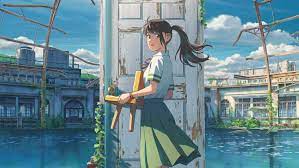With Your Name, Weathering with You, and now Suzume, Shinkai Makoto has achieved a distinctive artistic milestone: telling three spins on the same story but with such finesse each time that people call it a loose trilogy instead of a lazy formula (I’m looking forward to Master Gardener, coincidentally). Suzume indeed bears the hallmarks of its predecessors—melodramatic teen romance and supernaturally wrought disasters—but its historical weight where the latter is concerned is clearer now than ever.
READ ALSO: Read all of Ryan Bordow’s movie reviews here
READ ALSO: Here’s how Arizona film incentives could attract filmmakers
Mass Japanese suffering looms heavy over Shinkai’s trilogy, from echoes of the A-bomb in Your Name’s town-destroying comet to the climate change allegory of Weathering’s endless rain, but not until Suzume does Shinkai integrate a specific disaster: the 2011 Tōhoku earthquake and tsunami. Suzume, another Shinkai high school girl, was orphaned by the disaster, now spending her days on Kyushu with her overly protective aunt. En route to school one day, Suzume runs into Souta, a young man tasked with containing a giant spirit worm that could trigger a Tōhoku-magnitude earthquake. She’s unaware of this calling at first, but some light stalking (Souta’s face is very stalkable) leads her down the path of revelation.
What follows is sillier than I expected. A god meant to help seal the worm away goes trickster mode, turning itself into a cat, Souta into a walking, talking chair, and the first half of the movie into a girl and her chair falling in love as they chase a magical cat across Japan. It’s a diverting plot structure that gives the film room to stretch: earnest characters, high-concept shenanigans, breathtaking animation, and a stirring score, all synthesized in service of a spirited cross-country adventure. That Suzume stays playful while keeping disaster in view from the start—unlike its predecessors, which built up to their disasters in later acts—is a testament to its tonal balance.
And balance is key to Shinkai’s vision here. Suzume is about living side by side with death, emphasis on the living: when death can come so sudden and soon, the sublimity of life is worth full-hearted surrender. That’s hardly an original theme for animation—Pixar’s been mining it for years—but Shinkai ensouls it with consummate care. Like all his work, the animation is so stunning that any given frame could bring me to tears. The compositions and colors, vivified by an immensely talented team and inspired by Studio Ghibli’s eye for detail, move with hyperreal wonder, pushing hand-drawn creations into glorious kineticism with tasteful applications of CG. That fluid, elaborate style amplifies the film’s every mood, from the melancholy of old ruins from past disasters—sites where Suzume and Souta must stop the worm from reemerging—to the giddy fun of a chair wobbling, clomping, and acrobating across Japan in pursuit of a giant-eyed cat. It’s high emotionalism across the emotional spectrum.
The film’s score, composed once again by Japanese rock band RADWIMPS, hits all the same spots. Sometimes it’s a jazzy, bouncy delight propelling the mood into the sunshine; sometimes it’s a haunting choral arrangement reminiscent of Keiichi Okabe’s work on Nier: Automata, filling the air of abandoned places with the voices of their ghosts. The tonal tightrope the film walks visually, sonically, and thematically forms the apogee of Shinkai’s disaster narratives—fragile beauty and exquisite silliness above the chasm of inevitability. Even more so than Your Name, Suzume captures the dichotomous loss and joy reverberating through Japanese history.
Where it falls short of Your Name, still Shinkai’s strongest work over all,is in its central relationship and ending. Concerning the former, Suzume and Souta sure make a cute couple, but their romance is scarcely convincing. It’s partly because Souta’s a chair for most of the runtime—it’s a great sight gag, but it leaves little room for embodied feeling, something Your Name did magisterially—and mostly because the romance clashes with the film’s otherwise balanced tone. The pair’s final standing is just too optimistic for a film evoking the Tōhoku disaster. The same could be said of the ending, which reduces the film’s themes to a simple, saccharine life lesson delivered in teary monologue—one including the line “the future’s not that scary” in, again, a film evoking the Tōhoku disaster. Living side by side with real death is at least a little scary, and Suzume circling back to the same mostly sweet ending that Your Name and Weathering shared feels dishonest with that in mind.
Still, Shinkai keeps returning to this template for a reason. Teen emotion pairs well with metaphysical parable: if there’s some infinite, transcendent element of whatever confluence makes up consciousness, then the most powerful human emotions—the ones felt most raw in youth—must be tied to it. They just have to be. From where else could Shinkai possibly draw such beauty?
★★★½ (3.5/5)




